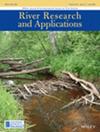溪流和河流是成年灯鱼产卵洄游的媒介:管理方面的考虑因素
IF 1.9
4区 环境科学与生态学
Q4 ENVIRONMENTAL SCIENCES
引用次数: 0
摘要
作为自然水流系统的一部分,生物已经适应了动态的河流水流。然而,气候变化和人类对淡水的使用导致地表水质和量的下降。此外,河流蓄水池和人类取水也调节和抑制了许多河流的动态水流。自然水流状态的这些变化会影响灯鱼(石首鱼类)的产卵洄游。在这里,我们的目标是回顾与河流水流相关的灯鱼产卵洄游生态学,并考虑如何控制外来入侵的海灯鱼(Petromyzon marinus)和保护本地灯鱼(包括本地溯河产卵的海灯鱼)。我们发现了五个共同的主题:(1)与非本地鱼类相比,自然水流机制为本地鱼类提供了竞争优势;(2)大流量(达到阈值)会吸引成年灯鱼,大的溪流会吸引大量灯鱼;(3)幼年灯鱼信息素会吸引成年灯鱼;(4)成年灯鱼对水流的行为反应(包括局部水力学)可以为大坝通过和诱捕方法提供参考;(5)气候变化引起的河流变化会改变灯鱼的活动时间和产卵地点。可以通过信息素和流量管理来控制外来灯鱼和保护本地灯鱼。信息素在控制入侵海鳗的重点管理工作中可能更有用,而流量管理则可为保护本地灯鱼奠定基础。本文章由计算机程序翻译,如有差异,请以英文原文为准。
Stream and river flows mediate adult lamprey spawning migrations: Considerations for management
Organisms have adapted to dynamic river flows as part of the natural flow regime. However, climate change and humans' use of fresh water are associated with decreases in the quality and quantity of surface waters. In addition, river impoundments and water withdrawals for human use regulate and dampen the dynamism of flow in many rivers. These changes to the natural flow regime can impact the spawning migrations of lampreys (Petromyzontiformes). Here, our goal is to review the ecology of lamprey spawning migrations associated with river flows, with considerations for controlling invasive sea lamprey (Petromyzon marinus ) and conserving native lampreys (including native, anadromous sea lamprey). We identify five common themes: (1) natural flow regimes provide a competitive edge to native fishes over non‐native fishes; (2) high flows (up to a threshold) attract adult lamprey and large streams attract large numbers of lamprey; (3) larval lamprey pheromones attract adult lampreys; (4) behavioral responses by adult lamprey to flow (including localized hydraulics) can inform dam passage and trapping methods; and (5) changes to rivers induced by climate change have been implicated in changing the phenology of run timing and spawning location. Controlling invasive sea lamprey and conserving native lampreys can be done with pheromones and flow management. Pheromones may be of more use under focused management efforts to control invasive sea lamprey, whereas flow management can provide a foundation for conservation of native lampreys.
求助全文
通过发布文献求助,成功后即可免费获取论文全文。
去求助
来源期刊

River Research and Applications
环境科学-环境科学
CiteScore
4.60
自引率
9.10%
发文量
158
审稿时长
6 months
期刊介绍:
River Research and Applications , previously published as Regulated Rivers: Research and Management (1987-2001), is an international journal dedicated to the promotion of basic and applied scientific research on rivers. The journal publishes original scientific and technical papers on biological, ecological, geomorphological, hydrological, engineering and geographical aspects related to rivers in both the developed and developing world. Papers showing how basic studies and new science can be of use in applied problems associated with river management, regulation and restoration are encouraged as is interdisciplinary research concerned directly or indirectly with river management problems.
 求助内容:
求助内容: 应助结果提醒方式:
应助结果提醒方式:


